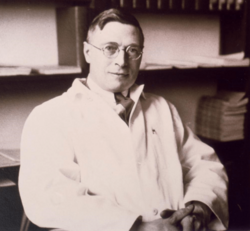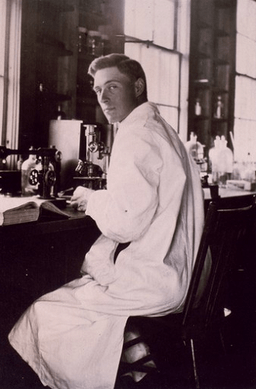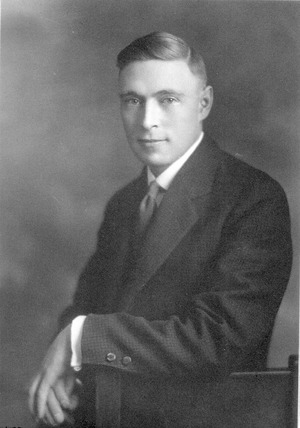James Collip facts for kids
Quick facts for kids
James Bertram Collip
|
|
|---|---|

J.B. Collip in his office at McGill University, ca.1930
|
|
| Born |
James Bertram Collip
November 20, 1892 |
| Died | June 19, 1965 (aged 72) |
| Citizenship | Canadian |
| Alma mater | University of Toronto |
| Known for | Insulin |
| Awards | Flavelle Medal (1936) Cameron Prize for Therapeutics of the University of Edinburgh (1937) Fellow of the Royal Society |
| Scientific career | |
| Fields | Biochemistry |
James Bertram Collip (born November 20, 1892 – died June 19, 1965) was an important Canadian scientist. He was a biochemist, which means he studied the chemistry of living things. Collip was part of a famous team in Toronto that discovered insulin. Insulin is a medicine that helps people with diabetes. He also led important departments at McGill University and the University of Western Ontario.
Contents
Early Life and Learning
James Collip was born in Belleville, Ontario. He started studying at the University of Toronto when he was just 15 years old. He focused on physiology (how living things work) and biochemistry. In 1916, he earned his Ph.D. in biochemistry from the same university.
A Career in Science
In 1915, at age 22, Collip became a lecturer at the University of Alberta in Edmonton. He taught in the physiology department. He stayed there for seven years, eventually becoming a professor and head of the biochemistry department in 1922. At that time, his research mainly looked at the blood chemistry of different animals.
In 1921, Collip took a break from his work. He traveled to Toronto on a special scholarship. There, he joined Professor J. J. R. MacLeod's team at the University of Toronto. Collip's research focused on how pH levels affect sugar in the blood. This work took him to marine biology stations in Woods Hole, Massachusetts and Saint Andrews, New Brunswick. He returned to Toronto later that year.
The Discovery of Insulin
Professor MacLeod was supervising the work of Frederick Banting and Charles Best. They were trying to find a treatment for diabetes. In December 1921, Banting and Best were having trouble making a pure enough extract from the pancreas. MacLeod asked Collip to join the team. Collip's job was to make a purer, more usable form of insulin.
In January 1922, a 14-year-old boy named Leonard Thompson had a bad reaction to an insulin injection. Collip then succeeded in making a very pure extract. This purer insulin helped Thompson recover. It was then used successfully in other patient tests.
The team of Banting, Best, and Collip later shared the patent for insulin. They sold it to the University of Toronto for just one dollar. This made sure the life-saving medicine would be available to everyone.
In 1923, the Nobel Prize for Medicine was given to Banting and MacLeod. Banting felt that Best had been overlooked, so he shared his prize money with Best. MacLeod then shared his prize money with Collip. However, Collip is sometimes forgotten as a key person in the discovery of insulin.
After this big success, Collip went back to Edmonton. He became the head of the new Department of Biochemistry there. He continued his studies on hormones. In 1928, he moved to McGill University in Montreal. He led McGill's Department of Biochemistry from 1928 to 1941. From 1947 to 1961, Collip was the Dean of Medicine at the University of Western Ontario. He is known as a pioneer in endocrine research. He did important work with the parathyroid hormone (PTH).
James Collip passed away on June 19, 1965, at the age of 72.
Awards and Recognition
- Fellow of the Royal Society of Canada, 1925
- Fellow of the Royal Society, 1933
- Honorary Doctorate from Harvard University, 1936
- Cameron Prize for Therapeutics of the University of Edinburgh, 1937
- Commander of the Order of the British Empire, 1943
- Honorary Doctorate from University of Oxford, 1946
- Honorary Doctorate from University of Alberta, 1946
- Medal of Freedom with Silver Palm (US), 1947
- Banting Medal of the American Diabetes Association, 1960
- Honorary Doctorate from the University of Western Ontario, 1964
See also
 In Spanish: James Collip para niños
In Spanish: James Collip para niños



